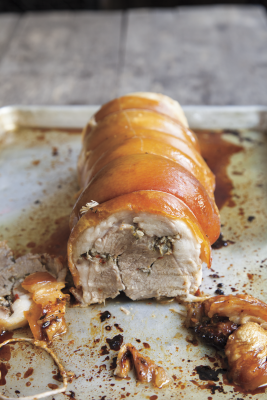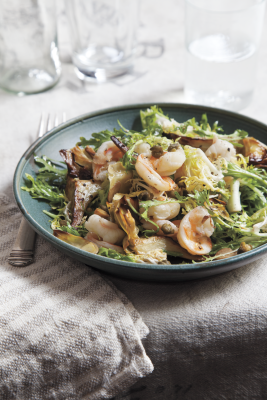Take a LISTEN:
SCRAMBLED EGGS
Heat an 8-inch nonstick pan over medium heat. When
the pan is hot enough to melt butter but not hot enough
to brown it, add the butter. Add the 4 eggs and a pinch of
salt before the butter is fully melted—you want some of
the water from the butter to mix in with your egg to help
inflate them with steam. Poke the eggs with a spatula to
break the yolk before the whites begin to set. If the whites
begin to set immediately on hitting the pan, remove the
pan from heat. Stir the eggs with a silicone or wooden
spatula and mix until the eggs are uniformly blended.
Keep an eye on the eggs, stirring them as they begin to
set around the edges. Be especially vigilant once the eggs
have nearly all set: When you see only traces of liquid egg
on the bottom of the pan as you stir, remove the pan from
heat, stir the eggs one more time, and turn them out onto
a plate to serve immediately.
You don’t need to stir constantly to get good eggs. Stir
them enough to keep them from setting too hard in any
one place. If they start to set, break them up. Then you
can leave them alone until they seem ready to set again.
Turn them out of the pan when they’re just still glossy and
wet—they’ll cook another degree or two off heat.
Courtesy of Houghton Mifflin Harcourt
From Season with Authority: Confident Home Cooking
Stocks
SAUTÉED SHRIMP SALAD
SERVES 4 T O 6
If you start reading this recipe and are turned off because you’re intimidated by artichokes, don’t be! With some kitchen shears and lemon water, you can master prepping a ’choke in no time. If your artichokes have some brown spots on them, don’t worry—that’s just what happens to the vegetable in cold weather, not a sign of it rotting.
2 large globe artichokes
½ lemon
¼ cup olive oil, plus more as needed
4 garlic cloves, thinly sliced
2 cups dry white wine
Kosher salt
16 jumbo shrimp (about 1 pound), peeled, deveined, and halved lengthwise
Canola oil
¼ cup drained capers, rinsed and dried
1 large head frisée, torn into bite-size pieces (about 8 cups)
3 tablespoons Red Wine Vinaigrette (page 267)
Freshly ground black pepper
- First, trim all the spiky tops off the artichoke leaves by going around the artichoke with your kitchen shears. Peel off and discard the tough outer leaves from each artichoke until you get to the light yellow part with a trace of green. (This will mean removing most of the leaves off the artichoke—it will feel wasteful, but those outer leaves are fibrous and bitter.) When you get to the soft green center, cut off the pointed top of the leaves and peel the stem and bottom of the artichoke to reveal the white flesh or heart. You want to discard all the dark green parts. Slice the artichoke into 8 pieces, scooping out and discarding the fuzzy choke from each piece. You want to be thorough when removing the choke—no one wants a mouthful of that. As you are working, rub all the cut surfaces with the lemon half to prevent discoloration.
- In a large sauté pan, heat 2 tablespoons of the olive oil over high heat until shimmering. Add the artichokes and cook, stirring, until nicely browned, about 3 minutes. Add half of the garlic and cook, stirring, until the garlic is golden brown, about 1 minute. Slowly add 1 cup of the white wine and a pinch of salt. Reduce the heat to medium-high and cook until the artichokes are tender, about 5 minutes more. Remove from the heat and set aside in a warm place.
- In a separate large sauté pan, heat the remaining 2 tablespoons olive oil over high heat until shimmering. Add the remaining garlic and cook, stirring, until golden brown, 1 to 2 minutes. Add the shrimp and cook, stirring, until the shrimp starts to turn pink, about 1 minute. Add the remaining 1 cup wine and a pinch of salt and cook, stirring, until the shrimp are pink and cooked through, about 3 minutes more. Remove from the heat and set aside in a warm place.
- Line a plate with paper towels. In a small saucepan, heat enough canola oil to generously cover the bottom of the pan over high heat until the oil is shimmering. Add the capers and fry, stirring, until they turn almost brown and “blossom,” about 3 minutes. Using a slotted spoon, transfer the capers to the prepared plate to drain.
- In a large bowl, toss the frisée, artichokes, and shrimp with the vinaigrette, and season with salt and pepper to taste. Top with the fried capers and serve.

PORCHETTA
SERVES 8
When I was growing up in Italy, porchetta was just as popular there as barbecue or burgers are in the States. In Spoleto, where my brother now has a house, porchetta trucks are as common as the Good Humor man is here, serving porchetta sandwiches or by the kilo. The meat is always perfectly cooked—tender and so flavorful—and, it turns out, it’s so easy to make for a home cook. Most of the cooking is hands-off—all you need is a few hours, some herbs and seasonings, a warm oven, and a hearty appetite.
3 tablespoons fennel seeds
8 garlic cloves, mashed into a paste
5 tablespoons finely chopped fresh rosemary
5 tablespoons finely chopped fresh thyme leaves
2 tablespoons kosher salt
1½ tablespoons freshly ground black pepper
1½ tablespoons red pepper flakes
1 (6- to 7-pound) boneless pork shoulder, butterflied
½ cup olive oil
4 cups Chicken Stock (page 270) or store-bought
2 cups dry white wine
- In a small pan, toast the fennel seeds over medium-low heat until toasted and fragrant, about 3 minutes. Immediately transfer the seeds to a mortar and pestle and pound until finely ground.
- In a small bowl, make a cure by combining the garlic, rosemary, thyme, salt, black pepper, red pepper flakes, and fennel seeds until incorporated. Rub the pork shoulder with the cure, making sure you season both the inside and outside of the meat. Using kitchen twine, truss the pork shoulder. Place it on a large plate and refrigerate, uncovered, for about 24 hours.
- Preheat the oven to 450°F; position the rack in the middle of the oven.
- Place the pork in a large roasting pan. Rub the pork all over with the olive oil and add the chicken stock and wine to the pan. Roast the pork for 30 to 40 minutes, or until the skin starts to get crispy. Reduce the oven temperature to 300°F and continue to roast for about 3 hours, until the pork is fork-tender. Transfer the pork to a cutting board and let rest for about 20 minutes before carving.
Preheat oven to 350ºF. Lightly butter and flour a 9×13-inch pan.
In a large bowl, sift together 2 1/3 cups of the cake flour, baking powder,
and salt. Set aside.
Beat butter and sugar together with an electric mixer at medium speed
until they are light and creamed. Reduce the speed to low, then add
the eggs, one at a time, being sure that each egg is fully incorporated
before adding the next. Add the dry ingredients in thirds, alternating
with 1/3 cup of the milk. Add vanilla. Finally, toss the blueberries with
the reserved 1/3 cup of flour and fold them into the cake mixture.
Bake for 50 minutes, rotating after 25 minutes, until a tester comes out
clean and the cake springs back slightly when gently touched. Most of
the blueberries will sink to the bottom of the pan as the cake cooks.
Combine the water and sugar in a sauté pan just big enough to contain
the strips of bacon. Bring to a boil and cook until the sugar dissolves into
a syrup. Reduce the heat to low and submerge bacon in the syrup and stir
to coat. Remove to a rack to set and eat immediately (or within the hour).












